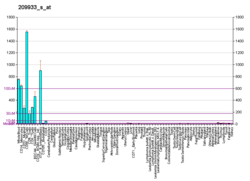CD300A
CD300A (Cluster of Differentiation 300A) is a human gene.[5]
The CMRF35 antigen (CMRF35A; MIM 606786), which was identified by reactivity with a monoclonal antibody, is present on monocytes, neutrophils, and some T and B lymphocytes. CMRF35H is recognized by the same antibody and is distinct from CMRF35 (Green et al., 1998).[supplied by OMIM][5]
See also
References
Further reading
- Clark GJ, Fitzpatrick S, Kuo B, et al. (2003). "CMRF-35A, CMRF-35H: potential new CD". J. Biol. Regul. Homeost. Agents. 16 (3): 233–5. PMID 12456026.
- Alvarez Y, Tang X, Coligan JE, Borrego F (2007). "The CD300a (IRp60) inhibitory receptor is rapidly up-regulated on human neutrophils in response to inflammatory stimuli and modulates CD32a (FcgammaRIIa) mediated signaling". Mol. Immunol. 45 (1): 253–8. doi:10.1016/j.molimm.2007.05.006. PMC 2000843. PMID 17588661.
- Bachelet I, Munitz A, Moretta A, et al. (2006). "The inhibitory receptor IRp60 (CD300a) is expressed and functional on human mast cells". J. Immunol. 175 (12): 7989–95. doi:10.4049/jimmunol.175.12.7989. PMID 16339535.
- Gerhard DS, Wagner L, Feingold EA, et al. (2004). "The status, quality, and expansion of the NIH full-length cDNA project: the Mammalian Gene Collection (MGC)". Genome Res. 14 (10B): 2121–7. doi:10.1101/gr.2596504. PMC 528928. PMID 15489334.
- Strausberg RL, Feingold EA, Grouse LH, et al. (2003). "Generation and initial analysis of more than 15,000 full-length human and mouse cDNA sequences". Proc. Natl. Acad. Sci. U.S.A. 99 (26): 16899–903. doi:10.1073/pnas.242603899. PMC 139241. PMID 12477932.
- Clark GJ, Green BJ, Hart DN (2000). "The CMRF-35H gene structure predicts for an independently expressed member of an ITIM/ITAM pair of molecules localized to human chromosome 17". Tissue Antigens. 55 (2): 101–9. doi:10.1034/j.1399-0039.2000.550201.x. PMID 10746781.
- Cantoni C, Bottino C, Augugliaro R, et al. (1999). "Molecular and functional characterization of IRp60, a member of the immunoglobulin superfamily that functions as an inhibitory receptor in human NK cells". Eur. J. Immunol. 29 (10): 3148–59. doi:10.1002/(SICI)1521-4141(199910)29:10<3148::AID-IMMU3148>3.0.CO;2-L. PMID 10540326.
- Green BJ, Clark GJ, Hart DN (1998). "The CMRF-35 mAb recognizes a second leukocyte membrane molecule with a domain similar to the poly Ig receptor". Int. Immunol. 10 (7): 891–9. doi:10.1093/intimm/10.7.891. PMID 9701027.
- Jackson DG, Hart DN, Starling G, Bell JI (1992). "Molecular cloning of a novel member of the immunoglobulin gene superfamily homologous to the polymeric immunoglobulin receptor". Eur. J. Immunol. 22 (5): 1157–63. doi:10.1002/eji.1830220508. PMID 1349532.
External links
- CD300A+protein,+human at the US National Library of Medicine Medical Subject Headings (MeSH)
- CD300a, Bernholtz - The Possible End to Asthma - The Future of Things article
- Human CD300A genome location and CD300A gene details page in the UCSC Genome Browser.
This article incorporates text from the United States National Library of Medicine, which is in the public domain.
This article is issued from
Wikipedia.
The text is licensed under Creative Commons - Attribution - Sharealike.
Additional terms may apply for the media files.





